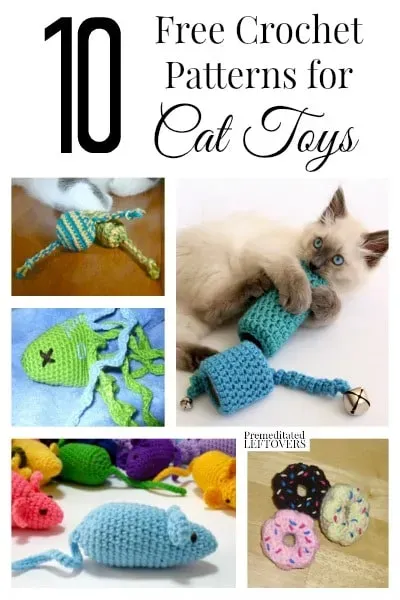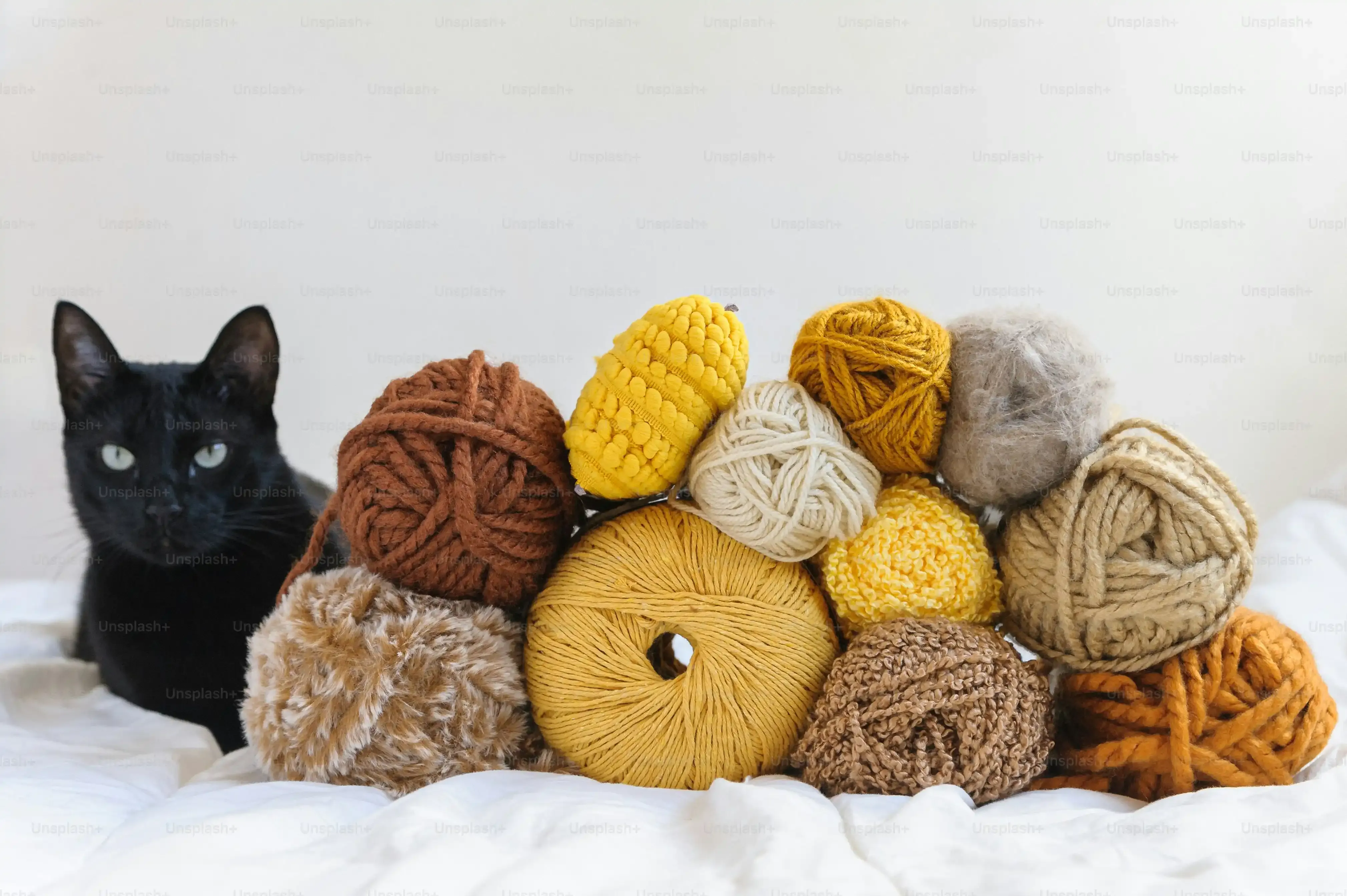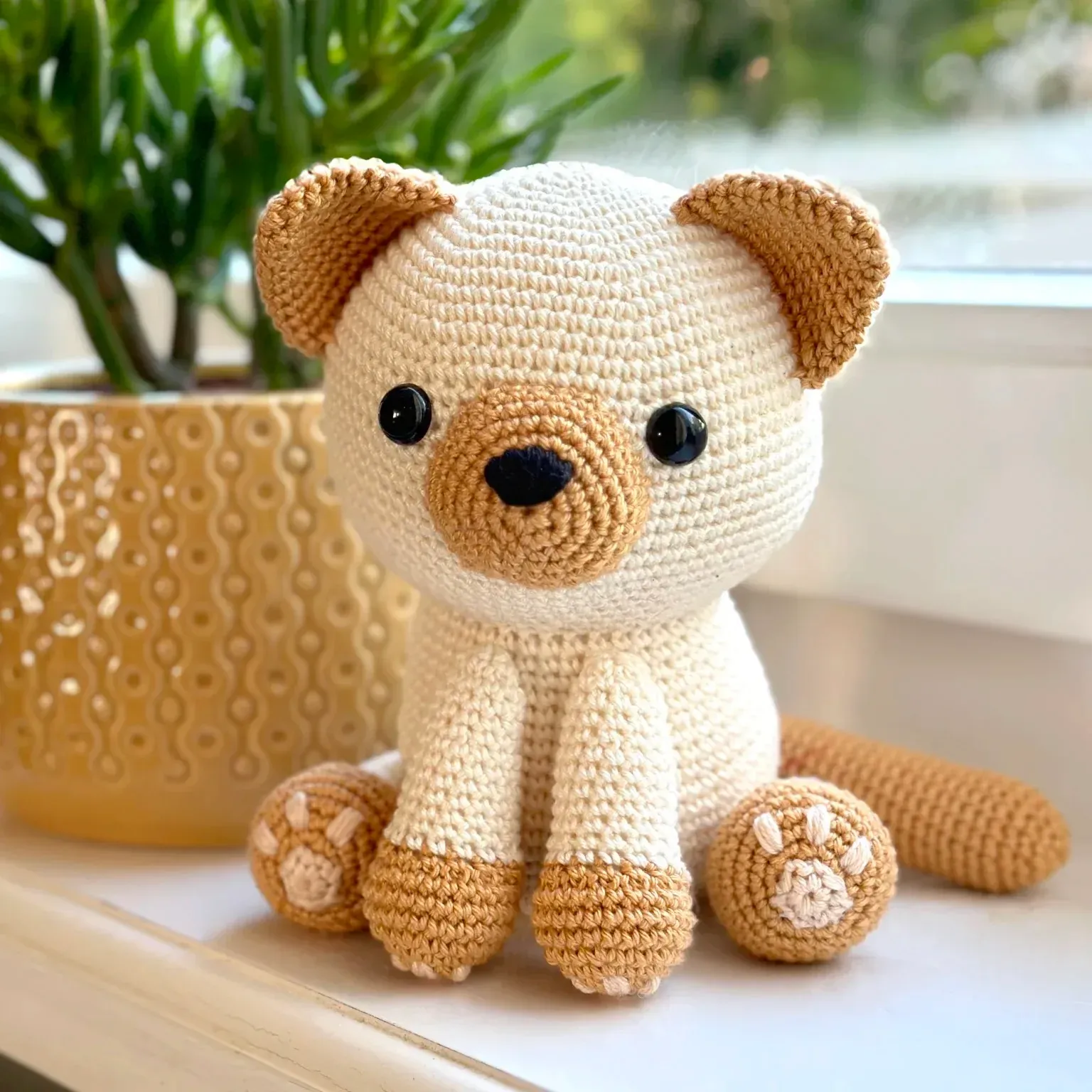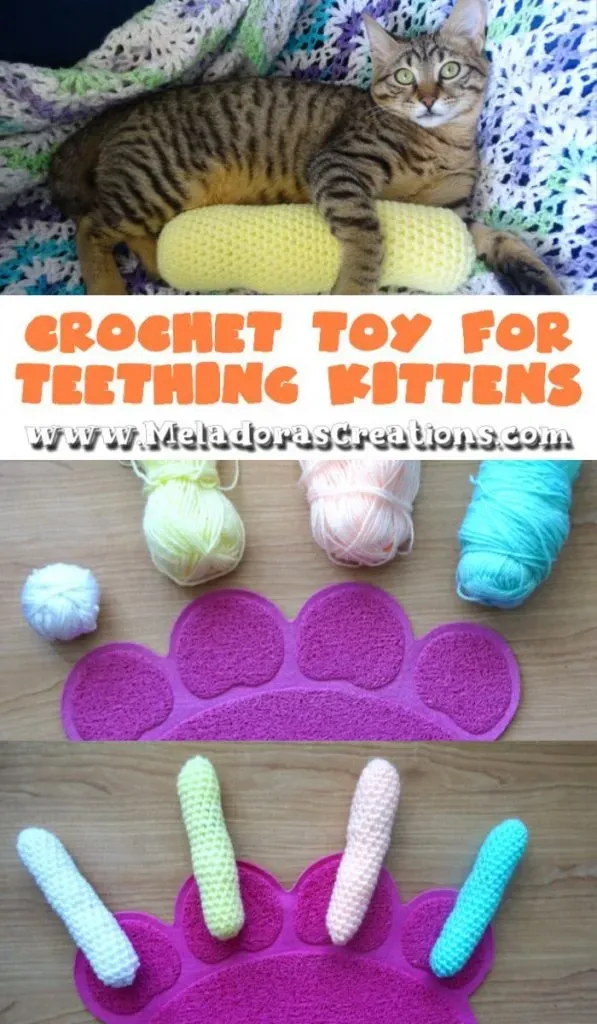Table of Contents
Let's be honest, keeping a cat entertained can feel like a full-time job. They chew on expensive things, ignore the fancy store-bought toys, and often find the most joy in a crumpled-up receipt. Sound familiar? What if you could whip up something they'd actually love, something safe, durable, and, best of all, free? That's where the wonderful world of crochet comes in, specifically finding fantastic free cat toy crochet patterns.
Why Crochet Cat Toys? It's Purrfectly Practical

Why Crochet Cat Toys? It's Purrfectly Practical
Beyond the Dollar Store Aisle
Ever stare at the pet store aisle, overwhelmed by the sheer volume of brightly colored, oddly shaped cat toys? And then you look at the price tags? Yeah, me too. Half of them look like they'll be shredded in five minutes flat, or worse, ignored entirely. That's where the practicality of crocheting your own cat toys really shines. You control the materials, ensuring they're safe and non-toxic, unlike some mass-produced items with questionable dyes or fillings. Plus, you can tailor the size, shape, and texture precisely to your cat's preferences. Does your cat love batting small things? Make a tiny mouse. Do they prefer to bunny-kick a larger object? Whip up a kicking stick. It's not just about saving a few bucks, though that's a nice perk. It's about creating something meaningful and perfectly suited for your furry friend's play style.
Think about it: that little crocheted ball filled with catnip isn't just a toy. It's a handmade expression of affection, a durable item that won't immediately fall apart at the seams, and a way to reduce waste from disposable plastic toys. You get the satisfaction of making something with your hands, and your cat gets a custom plaything. It’s a win-win, provided you pick the right yarn and stuff it properly. We'll get into those details later, but the basic principle holds: handmade often beats store-bought for durability and safety when it comes to things your cat puts in its mouth.
- Control materials for safety
- Customize size and shape
- More durable than many store toys
- Reduces waste
- Satisfying to create
A Tailored Play Experience
Cats aren't one-size-fits-all when it comes to play. Some go wild for crinkle sounds, others are obsessed with feathers, and some just want something soft to chew on. Finding free cat toy crochet patterns allows you to experiment and discover what truly gets your cat going. You can add bells (securely!), crinkle material inside, or even organic catnip that hasn't been sitting on a shelf for months. This level of customization is impossible with most store-bought options. My own cat, Mittens, is utterly indifferent to laser pointers (the weirdo), but she goes absolutely bonkers for a simple crocheted fish stuffed with potent catnip. I tried three different store-bought catnip toys before I figured that out. Crocheting let me pinpoint her specific preference without breaking the bank on failed experiments.
Furthermore, crocheting provides an endless supply of entertainment. Toys get lost. They get destroyed. Instead of running to the store, you can just grab your hook and yarn and make a replacement in an evening. It’s a sustainable cycle of creation and play. Plus, the texture of crochet can be particularly appealing to cats; the looped yarn provides something interesting to sink their claws into (in a good way!) and bat around. This tactile appeal is often missing in smooth plastic or fabric toys. So, while it might seem like a quaint hobby, crocheting cat toys is actually a highly practical approach to feline enrichment.
Gather Your Gear: Supplies for Free Cat Toy Crochet Patterns

Gather Your Gear: Supplies for Free Cat Toy Crochet Patterns
Hook, Yarn, and Stuffing: The Essentials
Alright, so you're convinced. Making your own cat toys sounds like a genuinely good idea. But what exactly do you need to get started? It's not like you need a workshop full of fancy tools. The beauty of finding free cat toy crochet patterns is that the material list is usually pretty short and budget-friendly. First off, you need a crochet hook. They come in different sizes, and the pattern you choose will tell you which one to use, but a basic set covering sizes G (4.0mm) to J (6.0mm) is a solid starting point for most toy patterns. Then there's the yarn. This is crucial. You absolutely do *not* want to use delicate, fuzzy yarn that your cat can easily ingest. Stick to sturdy, washable fibers like acrylic or cotton. Cotton is great because it's natural, but acrylic is often more durable and easier to clean. Avoid anything with loose fibers, glitter, or anything else that could be a choking hazard or cause digestive upset. Think plain, tough, and washable.
The third key ingredient is stuffing. You can use standard poly-fil, like what's in most pillows and stuffed animals. Just make sure it's fresh and clean. Some people like to add a little crinkle material – clean plastic bags or crinkle paper work, just make sure it's completely enclosed and secured. And of course, if your cat is a catnip connoisseur, you'll want some fresh, organic catnip to tuck inside. Make sure the stuffing is packed firmly so the toy holds its shape and is less likely to be torn open easily. Loose stuffing is an invitation for destruction and potential mess.
- Crochet Hooks (Sizes G to J are a good start)
- Sturdy Yarn (Acrylic or Cotton recommended)
- Poly-fil Stuffing
- Scissors
- Yarn Needle (for weaving in ends)
- Optional: Catnip, Crinkle Material, Jingle Bells (securely enclosed!)
Choosing Safe Materials for Playtime
Picking the right yarn isn't just about how it looks; it's about safety. Your cat is going to bite, claw, and potentially ingest tiny bits of whatever you make. This isn't a fashion project; it's a chew toy. Avoid natural fibers like wool that can felt and cause digestive issues if swallowed in large quantities. Also, steer clear of novelty yarns with sequins, beads, or metallic threads. These are absolute no-gos. Stick to smooth, tightly spun yarns. The tighter the spin, the harder it is for tiny claws and teeth to pull fibers loose. Acrylic yarn is often a good choice because it's synthetic, durable, and generally non-toxic, plus it washes well. Cotton is also excellent, just ensure it's a sturdy variety, not a fine, mercerized type.
When it comes to stuffing, poly-fil is standard, but you can also use scraps of fabric or old t-shirts cut into small pieces. Just ensure whatever you use is clean and doesn't contain small, hard pieces. If you decide to include bells or crinkle material, they must be completely encased within the stuffing and yarn layers, with no way for your cat to access them. A bell that comes loose is a serious choking hazard. Think about the worst-case scenario – your cat tearing the toy apart – and choose materials that minimize risk even then. It might sound overly cautious, but better safe than dealing with a vet visit because Bartholomew ate a bell.
Starting Simple: Easy Free Cat Toy Crochet Patterns

Starting Simple: Easy Free Cat Toy Crochet Patterns
First Stitches: Finding Beginner-Friendly Patterns
Alright, you've got your hook and yarn, maybe a suspicious amount of catnip. Now what? Don't panic. You don't need to start with a miniature crocheted replica of the Sphinx for your cat. The beauty of finding free cat toy crochet patterns is that there are tons designed specifically for total beginners. We're talking simple shapes, basic stitches, and quick gratification. Look for patterns that use stitches like single crochet (sc) or double crochet (dc). These are the building blocks, and most easy patterns rely heavily on them.
Where do you find these magical, beginner-friendly guides? The internet is your friend. Ravelry, Pinterest, and countless crochet blogs host a treasure trove of free patterns. Search terms like "easy cat toy crochet," "beginner amigurumi cat toy," or "simple crochet mouse pattern." Many patterns come with step-by-step photos or even video tutorials, which are incredibly helpful when you're just starting out. Pick something small, like a simple ball or a basic catnip mouse. Finishing a project quickly gives you a confidence boost and, more importantly, gives your cat something to immediately judge your crafting skills with.
What makes a pattern easy for beginners?
- Uses only a few basic stitches (sc, dc).
- Works up quickly (an hour or two).
- Involves simple shapes (circles, tubes).
- Clear instructions, often with photos.
- Requires minimal finishing work.
Mastering the Mouse and the Ball
So, what do these easy patterns actually look like? Often, they involve crocheting in the round to create simple spheres or ovals. A basic ball is just increasing stitches until you reach the desired size, then crocheting even rounds, and finally decreasing to close. Stuff it before you fully close it, obviously. A classic catnip mouse usually starts with a similar ball shape for the body, then adds a smaller circle for the head, and maybe a simple chain for a tail. Some patterns might have you crochet two flat pieces and sew them together, which can also be very straightforward.
These projects are excellent for practicing consistent tension and learning how to read a simple pattern. They don't require complex shaping or fancy techniques. You get to focus on the fundamentals: making your stitches even, counting rounds, and joining pieces cleanly. Plus, you can churn out several in an evening, providing your cat with a whole arsenal of new playthings. My first successful crochet project was a slightly lopsided grey mouse that my cat, despite its imperfections, instantly adopted as her favorite. Proof that perfection isn't required for feline approval.
Level Up Your Yarn Game: Creative Free Cat Toy Crochet Patterns

Level Up Your Yarn Game: Creative Free Cat Toy Crochet Patterns
Beyond the Basic Ball and Mouse
so you've mastered the simple ball and the slightly-less-simple mouse. Your cat is mildly impressed, or at least hasn't completely destroyed your creations yet. Ready to try something a little more ambitious? The world of free cat toy crochet patterns extends far beyond basic shapes. You can find patterns for fish, birds, octopuses (those tentacles are fun for batting!), even tiny crocheted insects. These patterns often introduce new stitches like half double crochet (hdc) or slip stitch (sl st) for details, or involve color changes to create stripes or spots.
Finding these patterns is similar to finding beginner ones – hit up Ravelry, Pinterest, or search specific blogs. Look for terms like "amigurumi cat toy," "crochet fish cat toy," or "animal cat toy pattern free." Pay attention to the skill level indicated by the designer. If it says "intermediate," it might involve techniques you haven't tried, but don't be intimidated. Most patterns explain the stitches used, and there are countless video tutorials online for almost any crochet technique imaginable. It's about building on those fundamentals you've already started.
Adding Flair and Features
Once you're comfortable with slightly more complex shapes, you can start thinking about adding features that really engage your cat. Instead of just a plain body, add fins to that fish, wings to a bird, or extra long legs to a spider. These appendages provide different textures and movements for your cat to interact with. You can also play with different yarn textures (still sticking to safe materials, of course). A bit of boucle or chenille yarn (used sparingly and securely!) can add an interesting feel, though be extra cautious with how well it's attached and how easily fibers pull loose.
Think about sensory play too. Adding crinkle material inside isn't just for beginners; you can incorporate it into more complex shapes. Securely enclosing a small jingle bell adds auditory stimulation. Some patterns even incorporate loops or tails made from braided yarn or fabric scraps for your cat to grab onto. My most popular cat toy creation amongst my feline focus group (read: my two cats and my neighbor's cat) is a slightly wonky octopus with extra-long, slightly uneven tentacles made from different colors. They seem to love the unpredictability.
Ideas for adding flair to your crochet cat toys:
- Crochet or yarn tails, fins, or wings
- Embroidered eyes or details (avoid buttons!)
- Securely enclosed crinkle material
- Securely enclosed small jingle bells
- Using different yarn colors for stripes or patterns
- Adding braids or loops for grabbing
Combining Techniques for Unique Toys
Feeling confident? You don't have to stick strictly to one pattern. You can start mixing and matching elements. Like the head from one mouse pattern and the body from another? Go for it. Want to add tentacles from an octopus pattern to a basic ball? Why not? This is where you really start getting creative and making truly unique toys tailored to your cat's quirks. You can also explore techniques like surface crochet to add details onto a finished shape, or intarsia/tapestry crochet to create more intricate color patterns within the fabric itself.
Experimenting with hook sizes and yarn weights can also change the final product dramatically. Using a smaller hook with a given yarn will create a denser, firmer fabric, which might be more durable for aggressive chewers. A larger hook makes a looser fabric, which might be softer and more appealing to a gentle player. Don't be afraid to deviate from the pattern instructions once you understand the basics. The goal is to create something your cat loves, and sometimes that means a little improvisation. Just remember those safety guidelines about materials and securely fastening everything.
Safety First: Tips for Durable Crochet Cat Toys

Safety First: Tips for Durable Crochet Cat Toys
Picking Yarn That Survives the Attack
you've got your hook humming and a pile of adorable crocheted shapes forming. But before you hand over that almost-finished mouse to your tiny predator, let's talk safety and durability. Because a cute toy that falls apart instantly or, worse, poses a hazard, is just yarn waste and a potential vet bill. The yarn choice we discussed earlier is your first line of defense. Remember how we said avoid fuzzy stuff? That's because those little fibers are easily pulled loose by claws and teeth. Ingesting too much yarn is a fast track to a blocked digestive system, which is neither fun nor cheap to fix. Sticking to smooth, tightly spun acrylic or cotton is non-negotiable. Look for yarn labeled as "worsted weight" or "aran" – they tend to be sturdy and hold up well to abuse. This isn't the time for fancy mohair or delicate lace weight. Think industrial strength, but make it cute for your cat.
Consider the color too. While bright colors are fun for you, make sure the dyes are colorfast and non-toxic. Most standard acrylic and cotton yarns are fine, but if you're using something artisanal or hand-dyed, double-check its suitability for pet toys. The goal is a toy that can be slobbered on, chewed, and bunny-kicked repeatedly without shedding fibers or questionable chemicals. Finding free cat toy crochet patterns that specifically mention using durable yarns is a good sign the designer has thought about this.
Construction Matters: Securing the Goods
Beyond the yarn itself, *how* you crochet and finish the toy makes a huge difference in its lifespan and safety. You want a tight, dense fabric. Using a smaller hook size than the yarn band recommends can help achieve this. A tighter gauge means less space for claws to get stuck and fewer gaps for stuffing to escape. When stuffing, pack it *firmly*. A squishy toy is easier for a cat to flatten and potentially tear open. Use a yarn needle to weave in all your ends securely *inside* the toy, not just trimmed flush. A loose yarn tail is an irresistible invitation for chewing and unraveling.
If your pattern includes adding features like ears, tails, or appendages, sew them on with extra strong stitches using the same yarn or a sturdy sewing thread. Go over the seams multiple times. Anything that dangles or sticks out is a prime target for chewing and pulling. If you're adding bells or crinkle material, they absolutely must be enclosed within a separate, securely stitched pouch *inside* the main toy body before stuffing. Imagine your cat trying its absolute best to rip this thing apart – your stitching needs to withstand that onslaught. Buttons for eyes? Hard pass. Embroider eyes using sturdy yarn instead, making sure the stitches are tight and flat against the fabric.
Key Safety & Durability Checks:
- Is the yarn smooth and tightly spun?
- Is the fabric dense with no large gaps?
- Are all ends securely woven in?
- Are any added features (ears, tails) stitched on *very* firmly?
- Are bells/crinkle material double-secured inside?
- Are there any small parts (like buttons) that could be chewed off?
Inspect, Repair, or Retire: The Toy Lifecycle
Even the most well-made crocheted toy won't last forever if your cat is a dedicated destroyer. Regular inspection is crucial. Get into the habit of checking your cat's toys every few days, or after a particularly vigorous play session. Look for signs of wear: loose fibers, unraveling seams, holes where stuffing might be escaping, or any parts starting to come detached. If you spot minor issues, like a few pulled loops, you might be able to snip them carefully or use a needle to tuck them back in. If a seam is starting to split, reinforce it with strong stitches.
However, know when to retire a toy. If it's significantly damaged, unraveling extensively, losing stuffing, or if any added elements (even if previously secured) seem loose, it's time for it to go. Don't wait for your cat to ingest something they shouldn't. You can often salvage the catnip or stuffing (if it's still clean) and use it for a new toy. Think of it as a sustainable crafting cycle. Your efforts in finding those free cat toy crochet patterns and making the toy are valuable, but your cat's safety is paramount. A quick visual and tactile check is all it takes to prevent potential problems.
Hooked on Happiness: Your Cat (and Wallet) Will Thank You
So there you have it. Instead of watching your cat bat around a dust bunny, you can create something truly engaging with just a hook, some yarn, and a free pattern. It doesn't require a Ph.D. in Fiber Arts, just a willingness to try. You've got the basics, you know where to look for patterns, and you're armed with the knowledge to keep things safe. It's a simple way to bond with your pet, use up some yarn scraps, and avoid the pet store aisle filled with toys that cost more than your last coffee run. Give one of these free cat toy crochet patterns a shot. Worst case, you've learned a new stitch. Best case? You've just made your cat's new favorite thing.